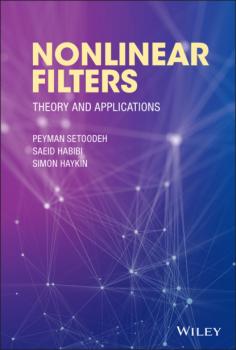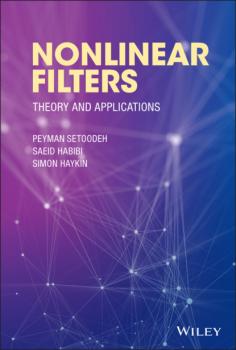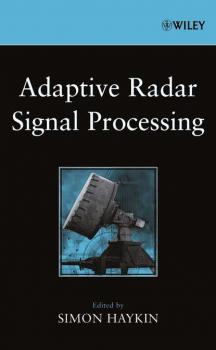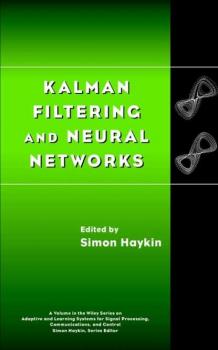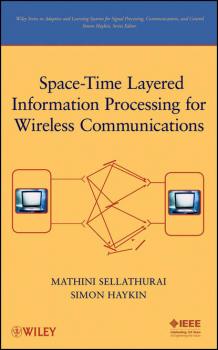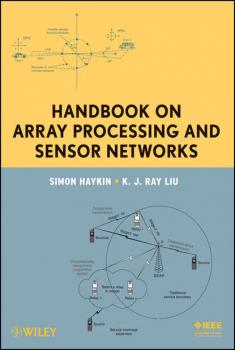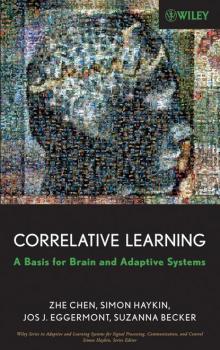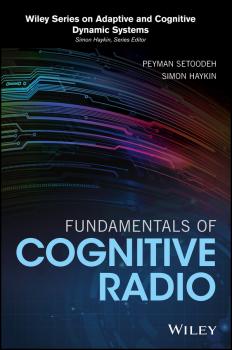Simon Haykin
Список книг автора Simon HaykinNonlinear Filters
NONLINEAR FILTERS Discover the utility of using deep learning and (deep) reinforcement learning in deriving filtering algorithms with this insightful and powerful new resource Nonlinear Filters: Theory and Applications delivers an insightful view on state and parameter estimation by merging ideas from control theory, statistical signal processing, and machine learning. Taking an algorithmic approach, the book covers both classic and machine learningbased filtering algorithms. Readers of Nonlinear Filters will greatly benefit from the wide spectrum of presented topics including stability, robustness, computability, and algorithmic sufficiency. Readers will also enjoy: Organization that allows the book to act as a stand-alone, self-contained reference A thorough exploration of the notion of observability, nonlinear observers, and the theory of optimal nonlinear filtering that bridges the gap between different science and engineering disciplines A profound account of Bayesian filters including Kalman filter and its variants as well as particle filter A rigorous derivation of the smooth variable structure filter as a predictor-corrector estimator formulated based on a stability theorem, used to confine the estimated states within a neighborhood of their true values A concise tutorial on deep learning and reinforcement learning A detailed expectation of the expectation maximization algorithm and its machine learning-based variants, used for joint state and parameter estimation Guidelines for constructing nonparametric Bayesian models from parametric ones Perfect for researchers, professors, and graduate students in engineering, computer science, applied mathematics, and artificial intelligence, Nonlinear Filters: Theory and Applications will also earn a place in the libraries of those studying or practicing in fields involving pandemic diseases, cybersecurity, information fusion, augmented reality, autonomous driving, urban traffic network, navigation and tracking, robotics, power systems, hybrid technologies, and finance.
Adaptive Radar Signal Processing
This collaborative work presents the results of over twenty years of pioneering research by Professor Simon Haykin and his colleagues, dealing with the use of adaptive radar signal processing to account for the nonstationary nature of the environment. These results have profound implications for defense-related signal processing and remote sensing. References are provided in each chapter guiding the reader to the original research on which this book is based.
Kalman Filtering and Neural Networks
State-of-the-art coverage of Kalman filter methods for the design of neural networks This self-contained book consists of seven chapters by expert contributors that discuss Kalman filtering as applied to the training and use of neural networks. Although the traditional approach to the subject is almost always linear, this book recognizes and deals with the fact that real problems are most often nonlinear. The first chapter offers an introductory treatment of Kalman filters with an emphasis on basic Kalman filter theory, Rauch-Tung-Striebel smoother, and the extended Kalman filter. Other chapters cover: An algorithm for the training of feedforward and recurrent multilayered perceptrons, based on the decoupled extended Kalman filter (DEKF) Applications of the DEKF learning algorithm to the study of image sequences and the dynamic reconstruction of chaotic processes The dual estimation problem Stochastic nonlinear dynamics: the expectation-maximization (EM) algorithm and the extended Kalman smoothing (EKS) algorithm The unscented Kalman filter Each chapter, with the exception of the introduction, includes illustrative applications of the learning algorithms described here, some of which involve the use of simulated and real-life data. Kalman Filtering and Neural Networks serves as an expert resource for researchers in neural networks and nonlinear dynamical systems. An Instructor's Manual presenting detailed solutions to all the problems in the book is available upon request from the Wiley Makerting Department.
Space-Time Layered Information Processing for Wireless Communications
Discover cutting-edge research in wireless communications This book presents cutting-edge research in wireless communications, particularly in the fast-growing subject of multiple-input multiple-output (MIMO) wireless communication systems. It begins with an introduction, which includes historical notes and a review of turbo-information processing and MIMO wireless communications, and goes on to cover: MIMO channel capacity BLAST architectures Space-time turbo codes and turbo decoding principles Turbo-BLAST Turbo-MIMO systems The material is complemented with abundant illustrations and computer experiments that are designed to help readers reinforce their understanding of the underlying subject matter. Space-Time Layered Information Processing for Wireless Communications is an ideal resource for researchers in academia and industry and an excellent textbook for related courses at the graduate level.
Handbook on Array Processing and Sensor Networks
A handbook on recent advancements and the state of the art in array processing and sensor Networks Handbook on Array Processing and Sensor Networks provides readers with a collection of tutorial articles contributed by world-renowned experts on recent advancements and the state of the art in array processing and sensor networks. Focusing on fundamental principles as well as applications, the handbook provides exhaustive coverage of: wavelets; spatial spectrum estimation; MIMO radio propagation; robustness issues in sensor array processing; wireless communications and sensing in multi-path environments using multi-antenna transceivers; implicit training and array processing for digital communications systems; unitary design of radar waveform diversity sets; acoustic array processing for speech enhancement; acoustic beamforming for hearing aid applications; undetermined blind source separation using acoustic arrays; array processing in astronomy; digital 3D/4D ultrasound imaging technology; self-localization of sensor networks; multi-target tracking and classification in collaborative sensor networks via sequential Monte Carlo; energy-efficient decentralized estimation; sensor data fusion with application to multi-target tracking; distributed algorithms in sensor networks; cooperative communications; distributed source coding; network coding for sensor networks; information-theoretic studies of wireless networks; distributed adaptive learning mechanisms; routing for statistical inference in sensor networks; spectrum estimation in cognitive radios; nonparametric techniques for pedestrian tracking in wireless local area networks; signal processing and networking via the theory of global games; biochemical transport modeling, estimation, and detection in realistic environments; and security and privacy for sensor networks. Handbook on Array Processing and Sensor Networks is the first book of its kind and will appeal to researchers, professors, and graduate students in array processing, sensor networks, advanced signal processing, and networking.
Correlative Learning
Correlative Learning: A Basis for Brain and Adaptive Systems provides a bridge between three disciplines: computational neuroscience, neural networks, and signal processing. First, the authors lay down the preliminary neuroscience background for engineers. The book also presents an overview of the role of correlation in the human brain as well as in the adaptive signal processing world; unifies many well-established synaptic adaptations (learning) rules within the correlation-based learning framework, focusing on a particular correlative learning paradigm, ALOPEX; and presents case studies that illustrate how to use different computational tools and ALOPEX to help readers understand certain brain functions or fit specific engineering applications.
Fundamentals of Cognitive Radio
A comprehensive treatment of cognitive radio networks and the specialized techniques used to improve wireless communications The human brain, as exemplified by cognitive radar, cognitive radio, and cognitive computing, inspires the field of Cognitive Dynamic Systems. In particular, cognitive radio is growing at an exponential rate. Fundamentals of Cognitive Radio details different aspects of the human brain and provides examples of how it can be mimicked by cognitive dynamic systems. The text offers a communication-theoretic background, including information on resource allocation in wireless networks and the concept of robustness. The authors provide a thorough mathematical background with data on game theory, variational inequalities, and projected dynamic systems. They then delve more deeply into resource allocation in cognitive radio networks. The text investigates the dynamics of cognitive radio networks from the perspectives of information theory, optimization, and control theory. It also provides a vision for the new world of wireless communications by integration of cellular and cognitive radio networks. This groundbreaking book: Shows how wireless communication systems increasingly use cognition to enhance their networks Explores how cognitive radio networks can be viewed as spectrum supply chain networks Derives analytic models for two complementary regimes for spectrum sharing (open-access and market-driven) to study both equilibrium and disequilibrium behaviors of networks Studies cognitive heterogeneous networks with emphasis on economic provisioning for resource sharing Introduces a framework that addresses the issue of spectrum sharing across licensed and unlicensed bands aimed for Pareto optimality Written for students of cognition, communication engineers, telecommunications professionals, and others, Fundamentals of Cognitive Radio offers a new generation of ideas and provides a fresh way of thinking about cognitive techniques in order to improve radio networks.
Kernel Adaptive Filtering. A Comprehensive Introduction
Online learning from a signal processing perspective There is increased interest in kernel learning algorithms in neural networks and a growing need for nonlinear adaptive algorithms in advanced signal processing, communications, and controls. Kernel Adaptive Filtering is the first book to present a comprehensive, unifying introduction to online learning algorithms in reproducing kernel Hilbert spaces. Based on research being conducted in the Computational Neuro-Engineering Laboratory at the University of Florida and in the Cognitive Systems Laboratory at McMaster University, Ontario, Canada, this unique resource elevates the adaptive filtering theory to a new level, presenting a new design methodology of nonlinear adaptive filters. Covers the kernel least mean squares algorithm, kernel affine projection algorithms, the kernel recursive least squares algorithm, the theory of Gaussian process regression, and the extended kernel recursive least squares algorithm Presents a powerful model-selection method called maximum marginal likelihood Addresses the principal bottleneck of kernel adaptive filters—their growing structure Features twelve computer-oriented experiments to reinforce the concepts, with MATLAB codes downloadable from the authors' Web site Concludes each chapter with a summary of the state of the art and potential future directions for original research Kernel Adaptive Filtering is ideal for engineers, computer scientists, and graduate students interested in nonlinear adaptive systems for online applications (applications where the data stream arrives one sample at a time and incremental optimal solutions are desirable). It is also a useful guide for those who look for nonlinear adaptive filtering methodologies to solve practical problems.
